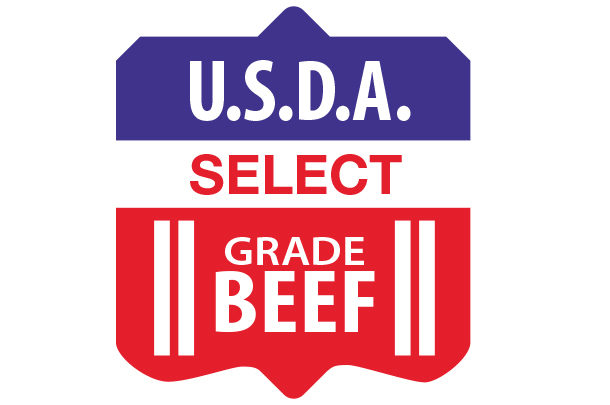Progress in genetics and management, coupled with rising consumer expectations, has skyrocketed the percentage of high-quality beef on shelves and in restaurants – so much it’s raised questions on how viable the Select grade will be in the near future.
In 2019, 8.4% of all cattle on the rail graded Prime, 70% were Choice, and 16.7% were Select. Some estimates predict Select will account for only 15% of all quality-graded beef by 2022 and 10% by 2025. Through the first 10 weeks of 2020 compared to the same period in 2019, Select grade beef production is down 0.67%, dropping from 14.49% to 13.82% of all graded beef.
While there is compelling evidence suggesting this decline is here for the long haul, lean beef products are still a market of their own. Certain cases may exist in which it is more profitable to raise an animal to the Select grade than Prime or Choice.
This discussion is a compelling and important one when you consider that 70% to 75% of all finished cattle sell on some kind of carcass-merit grid and formula pricing systems.
“If we look at this decade we just started, there’s very little doubt that the Select grade beef supply will continue to shrink,” says Tom Brink, CEO of the Red Angus Association of America. “It’s not going to go to zero, but it could very easily get below 10 percent, possibly closer to 5 percent by the end of the decade. Prime and Choice carcasses are worth significantly more than Select, and our industry is responding to that economic signal by reducing the production of Select grade beef.”
Interpreting the trends
To understand the role of Select beef, it helps to look at the history. In 1987, the USDA removed the “Good” beef grade and replaced it with “Select” in hopes to make these products more promotable as a lean meat. Interestingly, this was also the year of the best cattle grading in U.S. history. According to the USDA, during this year 2.2% of all beef carcasses graded Select, and 94.5% were Choice. Similar trends of record numbers continued through the late 1970s and ’80s.
“The pendulum of genetic selection has swung from extremely lean to extremely overfinished cattle … and well-to-overfinished cattle is where we are right now,” explains Ty Lawrence, professor of animal science at West Texas A&M University. “Then there was a shift toward leanness in a pretty dramatic move to the peak of Select. This appears to be in 2006 when we reached 40.9% grading Select; then the pendulum started swinging the other way. Every year since, Select decreased a little bit year over year.”
Major retailers like Walmart have increased their offerings of high-end Choice and Prime products, partly due to the success of branded beef programs and labels. There are 90 such programs listed by the USDA. Among the top 10 of these labels, nine have Choice or higher marbling as a requirement for entry, and eight require upper two-thirds Choice or Prime.
Catering to and creating demands
Not only is higher-quality beef demanded, it is expected more and more. What consumers want is part of the story, but the beef industry’s own marketing is certainly a factor.
Patrick Wall, area beef field specialist at Iowa State University Extension and Outreach, recalls a brief time when some Select boxed beef products were priced higher than Choice because the food service industry wanted consistency.
“Their customers were used to a certain grade, and they had trained their employees on how to cook it properly, and they really didn’t want to change, even to a higher-quality marbled product,” Wall says.
But as more major distributors increased their selection of Prime and Choice, and branded products made their marketing campaigns, consumers soon veered toward higher grades.
This has coincided with the export market as well, notes Travis Arp, senior director of the U.S. Meat Export Federation.
“Markets across Asia have always had high demand for high-quality beef,” Arp says. “While they purchase different cuts than what is popular in the domestic market, like short ribs, short plates and chuck rolls, there is high consumer recognition for Choice and Prime. With the growth in availability of these grades, we have seen our exports grow to these markets as well.”
Wall also adds that while the progression in genetics from technologies like carcass ultrasound have certainly played a role in getting the quality to where it is today, enhancing nutrition and increasing days on feed has also made an impact.
“The average consumer might not know – it may even scare us how little they know – about the difference between Choice and Select and why they prefer one grade over the other. For some, it’s just price,” Wall says.
Follow the money
Besides meeting consumer expectations, profitability is another big factor that accounts for either the decline or steady trend of Select. While finishing cattle to grade Prime or Choice has some nice incentives, the time on feed and often excessive finishing pose some contradictions to profitability.
For example, there are certain cuts of meat that demand leaner animals for them to have much value. Lawrence notes much of the focus is often on the middle meats, such as high-value steaks, but points out most of the carcass is more than these specific cuts. Many USDA boxed beef products are cuts that have no more value being Choice over Select; in fact at times they may be discounted for being Choice.
“The average consumer doesn’t want a really fatty roast because when they cook it, they don’t need a ton of grease in the bottom of the pan,” Lawrence explains. “Almost always, a leaner roast is often preferred. For that reason, in most all Prime carcasses the round and the chuck get downgraded into Choice because there’s minimal to no market for Prime roast.”
Another market supporting Select cuts are the aging and health-conscious population. In most cases, their physician may encourage them to choose leaner cuts. These consumers alone are enough to justify the continued production of Select beef in some capacity, Lawrence notes.
But domestically and internationally, the general market outlook is toward the higher-quality beef. According to Arp, every feedlot steer is expected to have some cuts that will go into export. Some cuts that almost exclusively go into these channels are things like short ribs, chuck short ribs and rib finger meat.
“Consumers around the world recognize and seek out Choice and Prime U.S. beef because of its superior quality, taste and flavor to our global competitors,” Arp says. “Continuing to do so will help continue to drive demand in the export markets and add value to the entire supply chain.”
There is no doubt the beef industry has seen its fair share of change and development throughout its rich history. It takes a look at the full scope of past and present to fully appreciate the consumer’s and industry’s gravitation to quality. The reaction producers should make in accord with this trend is dependent on market, resources available, breeds raised and many more factors. Equipped with a thorough understanding of the role of Select along with Prime and Choice grades, there are many ways for a beef producer to be profitable across the grading scale. ![]()
ILLUSTRATION: Illustration by Corey Lewis.
Jaclyn Krymowski is a freelancer based in Ohio.









